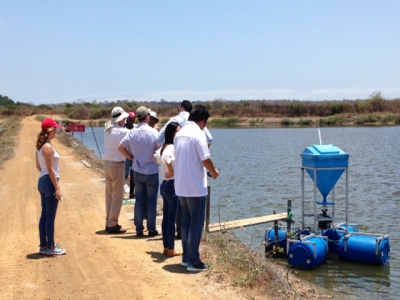Skretting using Ecuador validation station to show new shrimp feeding methods

EL MORRO, Ecuador - About two hours from Ecuador's largest city down a series of dirt roads that straddle hectares after hectares of shrimp ponds is a building that seems a bit out of place.
It's a modern looking red and grey structure owned by Norwegian feed maker Skretting, but there's no feed mill in sight. The "validation station", which recently hosted a visit of attendees from the Global Aquaculture Alliance's Global Outlook on Aquaculture Leadership conference, is used for customer demonstrations, training and research and development (R&D).
The center is used for “validation” as it allows the company to test and demonstrate new feed s and technologies in real world conditions, Cesar Molina Poveda, Skretting's head of R&D for Latin America, said.
The facility, which includes classrooms and office space, has seven shrimp ponds over 41 hectares. Skretting, which is owned by Nutreco, began using the station in 2016.
Skretting currently operates three feed plants in Ecuador with capacity of 350,000 metric tons and is building a fourth, a $65 million plant 2019, with an expected production capacity of 470,000t of pelleted and extruded feed. The company also operates a joint venture feed plant in Honduras with Regal Springs Tilapia.
Skretting, Ecuador's largest feed maker, has been expanding in the country to meet the demands of a shrimp sector that has grown by double digits annually for over a decade. Ecuador is expected to reach nearly 500,000t in shrimp output this year, around 17% higher than 2017.
The country could see even further growth, to 700,000t annually, in the next few years, according to a prediction that John Sackton, publisher of Seafood News, made during the International Congress on Global Fishery Production in Vigo, Spain, earlier this month. That forecast would see Ecuador overtake even India, which is the largest shrimp supplier to the US.
Automatic feeders
Skretting believes that automatic feeders and the use of "precision nutrition" techniques will be integral to boosting output at Ecuador's over 2,500 shrimp farms.
Poveda said by using premium feeds with better nutrition and automatic feeding devices, farmers can improve survivability and lower feed conversion ratios.
Prior to Skretting's establishing the validation station, the ponds there were producing 1,375 pounds of shrimp per hectare in 2015 to 2016 and shrimp were gaining an average of 1.1 grams per week of growth.
After improving the ponds' pumping systems, installing better feed and automatic feeders, those figures have improved he said.
During the August 2016 to December 2017 period, the same ponds were producing 3,257 lbs/ha and growth rates rose to 1.3 grams per week, he said.
Some automatic feeders are equipped with hydrophones that are able to detect the noises shrimp make while eating and deliver more food when they’re ready to consume it, Poveda said.
“Anytime when they are eating more, they are feeding more. So who is deciding how to feed the pond? It’s the shrimp, not the technician. That’s more efficient,” he said.
The main advantage is to feed more than once or twice a day, which speeds up growth rates.
Currently, the company estimates that only around 10% of the country's farms use automatic feeders, he said.
According to Manuel Espinoza, who heads R&D for Skretting Ecuador, the automatic feeders are powered by solar panels and use an computer “brain” that decides when and how much feed to release. The data they produce is transmitted over the internet and accessible to farmers via their mobile phones, he said.
One of the hardest parts of the system, he said, is determining where in the pond to set up “feeding zones” to deploy the feeders. Farmers have to study the pond's depth and water flow to determine where to position them, he said.
Có thể bạn quan tâm
Phần mềm

Phối trộn thức ăn chăn nuôi

Pha dung dịch thủy canh

Định mức cho tôm ăn

Phối trộn phân bón NPK

Xác định tỷ lệ tôm sống

Chuyển đổi đơn vị phân bón

Xác định công suất sục khí

Chuyển đổi đơn vị tôm

Tính diện tích nhà kính

Tính thể tích ao hồ



 Comparing biofloc, clear-water and hybrid RAS systems as…
Comparing biofloc, clear-water and hybrid RAS systems as…  Lobster shell disease moving towards Maine
Lobster shell disease moving towards Maine